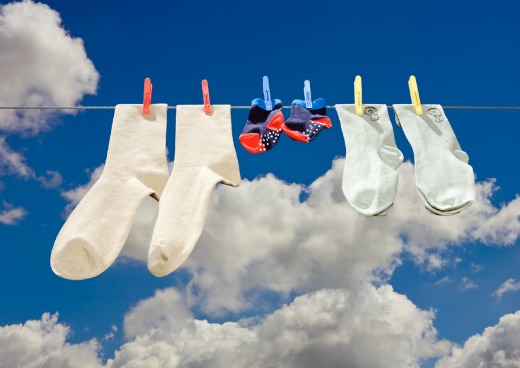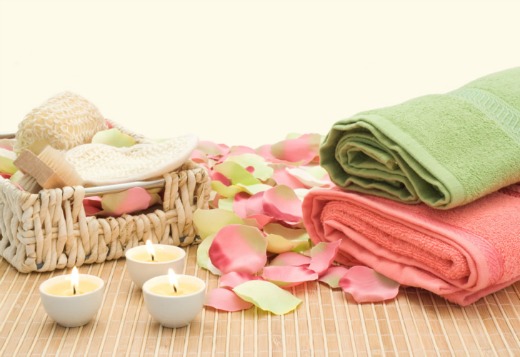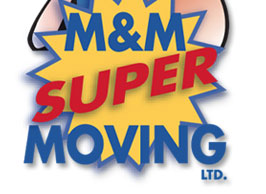Don’t Forget To Clean Before You Move Out!
Comments Off on Don’t Forget To Clean Before You Move Out!

When you finish moving all of your furniture and belongings into your new home, you probably won’t feel like going back to your previous residence to clean it. However, leaving it dirty could result in forfeiture of your security deposit – assuming it’s a rental. And if it wasn’t a rental, leaving it cluttered with dirt and debris will inevitably make it more difficult to sell.
Check each room of your old home and remove any nails, screws, or mounting kits stuck in the walls. If you decorated with paintings, framed photos, or any other type of wall art, chances are some of these items will be left behind.
Bring a Philips-head screwdriver, a hammer, and a step ladder to remove them. Most picture-hanging nails should come out with minimal effort, but some of the larger screws and mounting kits may require the use of a screwdriver.
Depending on the condition of your walls after removing your picture-hanging hooks and accessories, you may want to cover up the holes. The easiest solution to this problem is to fill in the holes with spackling paste. This stuff is made of gypsum plaster, containing a combination of calcium sulfate and glue. Spackling can be used to fill holes, cracks, and other forms of minor damage in drywall, wood and even plaster.
You might be surprised to see just how much dirt and debris is left behind on your floors after you finish moving. Areas underneath furniture and major appliances are usually the dirtiest simply because they are rarely (if ever) moved. Using a broom, dustpan and vacuum cleaner, clean the floors in your old home. If the kitchen floors are exceptionally dirty, you may want to mop them as well.
Now comes the fun part: scrubbing down the bathrooms and kitchen counters. Fill up a spray bottle with half white vinegar, half water, and spray it on your counters. Some people prefer to use bleach, but vinegar is a safer choice that’s equally as effective. And don’t worry about its pungent odor, as this dissipates within minutes of exposure to the air. Continue scrubbing down your bathroom and kitchen until it’s clean, at which point you begin to wrap things up at your old residence.
Perform a final walkthrough of your old residence to ensure it’s clean. If the blinds or fan blades are dusty, knock them with a feather dusty. Also, double-check the kitchen cabinets, closets, basement and attic. Assuming it’s clean, you can throw away the remaining trash and head out the door.
Our team of moving professionals are here to help. We specialize in making your move as stress-free as possible and we would love to help with your next move. Get a free online moving quote today.
Published in categories: Home Moving Tips
Secrets To Packing and Moving Clothes
Comments Off on Secrets To Packing and Moving Clothes

When it comes to packing and moving clothes, you have to think outside of the box. Taking the same approach as the rest of your belongings, by stuffing them inside traditional boxes, will likely turn them into a wrinkled mess. Granted, you can always re-wash and dry your clothes after settling into your new home, but there are other, more energy-efficient methods for packing clothes.
Before we go into the various techniques on how to pack and move clothes, it’s important to note that garments should be separated based on who owns them. Don’t make the mistake of packing all of your family’s clothing together, as doing so will force you to separate it after you move – a tedious task that can be avoided with labels.
If you have travel luggage laying around your home, you should use it to store some of your garments. Just a single medium-to-large-sized luggage bag can hold a dozen or so different garments. And best of all, most name-brand luggage is designed to protect clothing against wrinkles and damages. Just remember to label the outside so you know who the garments belong to.
When packing your garments in a suitcase or luggage bag, take a minute or two to neatly fold them beforehand. As long as they aren’t tossed around too much during transit, they should hold their form without developing wrinkles.
Garment bags may also prove useful when packing clothes for a move. A vinyl zippered garment bag can safely hold several different garments, protecting them against in-transit damage. You can usually purchase them online or in various apparel and department stores.
Garment bags are available in reusable and disposable models. The reusable type feature a synthetic material with a zipper on the front, whereas the disposable type are usually made of a clear plastic wrap. Disposable garment bags cost less for obvious reasons, but they aren’t quite as effective at protecting garments.
While traditional boxes are typically a poor choice for packing shirts, pants and other “large” garments, they can still be used for socks, underwear, ties, scarves, and other small items. Go through your wardrobe and transfer small garments such as this into a medium-sized box.
There are boxes designed specifically for garments on hangers. Also known as wardrobe boxes, these exceptionally tall boxes feature a built-in metal bar at the top that’s used to hang garments. The downside to using wardrobe boxes, however, is their cost. At $30-$40 bucks a pop, moving an entire wardrobe via these boxes can quickly burn a hole in your wallet.
Our team of moving professionals are here to help. We specialize in making your move as stress-free as possible and we would love to help with your next move. Get a free online moving quote today.
Published in categories: Home Moving Tips, Packing Tips
What Items Need To Be Stored In a Climate Controlled Storage Facility
Comments Off on What Items Need To Be Stored In a Climate Controlled Storage Facility

Extreme heat, cold and fluctuating humidity can wreak havoc on your belongings, causing things to warp, shrink, tear, and even develop mold. Don’t assume that your items are safe just because they are kept in a storage facility. Unless it’s climate-controlled, some of your items could be vulnerable to damage. This is why it’s important to know which items should be stored in a climate controlled storage facility, and which items can be safely stored in a non-climate-controlled facility.
Before moving your belongings into a storage unit, you should create two different stacks: one stack for items which require a controlled climate, and a second stack for items which do not require climate control.
Most electronics require a controlled climate to remain operational. High heat and humidity may cause water to form, promoting rust and/or causing an electrical short the next time the device is turned on. Water damage is a serious threat to electronic devices, and nine out of ten times, there’s no easy fix for it.
Commonly used electronics that should be stored in a climate-controlled facility include:
- Televisions
- Computers
- Monitors
- Video game consoles
- Stereo systems
- MP3 players
- Blu-Ray and DVD players
- Clocks
- Car stereos
Other items that should be stored in a climate-controlled facility include:
- Photographs
- Paintings
- Wine
- Books
- Antiques
- Clothes
- Anything made of genuine leather
Some people assume that furniture does not require a controlled climate. Even if it’s thick, hardwood furniture, however, it can still damage under the stress of heat and humidity. This is due to the fact that wooden furniture absorbs moisture from its surroundings, at which point it may warp, rot, and/or grow mild. Wooden furniture is naturally porous and able to absorb small amounts of moisture without suffering any damage. When exposed to a humid atmosphere, however, the excess moisture floods the furniture’s pores to the point where it warps and promotes rot. The bottom line is that you should only store wooden furniture in a climate-controlled facility.
If the furniture is made of plastic, vinyl or some other type of inorganic, synthetic material, you can probably store it in a non-climate-controlled storage facility. Plastic and vinyl are incredibly tough and able to withstand high temperatures and humidity.
Hopefully, this will give you a better idea of what needs to be stored in a controlled climate and what doesn’t.
Our team of moving professionals are here to help. We specialize in making your move as easy and stress-free as possible and we would love to help with your next move. Get a free online moving quote today.
Published in categories: Storage
Things People Forget To Do When Moving
Comments Off on Things People Forget To Do When Moving

There will probably be hundreds of things going through you head while you prepare to move. From labeling all of your boxes to contacting and scheduling an appointment with a professional moving company, these are just a few of the many responsibilities you’ll have. While most people will remember ‘obvious’ tasks such as these, it’s the smaller ones that may go unnoticed.
Submitting a Change of Address Mail Forwarding
Have you submitted a change of address mail forwarding form with the local Post Office yet? Failure to submit this form will result in your mail being sent to your old residence. It only takes a couple of minutes to set up a mail forwarding address, so make sure you take care of this before you move.
You can submit a change of address by visiting the local USPS office in person or by accessing the following website: https://moversguide.usps.com/icoa/mailforwarding/change-of-address?state=coa. Note: you’ll have the option to choose a starting and ending date for the mail forwarding service.
Notifying School
If you’re the parent of one or more children whom are currently enrolled in the local school system, you should contact the office to inform them of the move. Depending on the location of your new home, your child may be required to enroll in a different school.
Purchase Light Bulbs
Another task people often forget when moving is purchasing light bulbs. Whether you’re moving into a new or used home, chances are it will need additional bulbs. Builders and real estate agents typically place a few bulbs in the most critical areas, but the remaining fixtures might be left empty.
Rather than purchasing incandescent light bulbs to use in your new home, consider using compact fluorescent bulbs (CFL) instead. A standard incandescent bulb runs for approximately 1,200 hours while using 60 watts of power. A CFL bulb runs for 8,000 hours and uses just 13-15 watts of power.
Doing The Walk-Through
If your previous residence was an apartment or rented house, you may be required to perform a walk-through with the landlord/owner before moving out. This is done to ensure there’s no permanent damage done to the property. And if you have a security deposit vested into your previous residence, a walk-through is an essential step in recovering this money.
Transfer or Cancel Utilities
Make sure you either cancel or transfer the utility services from your old home to your new home. This includes power, gas (if applicable), phone, security monitoring, cable, Internet, phone, and waste disposal. Overlooking this step could result in you paying to power your old residence – even if there’s no one there.
Our team of moving professionals are here to help. We specialize in making your move as easy and stress-free as possible and we would love to help with your next move. Get a free online moving quote today.
Read more Home moving tips here.
Published in categories: Home Moving Tips
Eco-Friendly Tips For a Green Move
Comments Off on Eco-Friendly Tips For a Green Move

There’s a growing trend towards eco-friendly practices in today’s society. As scientists continue to stress the importance of reducing carbon emissions, more and more people are taking steps to promote a green lifestyle. If you’re planning on moving in the near future, you should consider some of the following eco-friendly tips for a green move.
Make Fewer Trips
The more trips you are forced to make, the more gas you’ll use. Not only does this add carbon emissions to the atmosphere, but it’s also going to cost you money. Whether you hire a professional moving company to haul your stuff, or if you rent a moving truck and do it yourself, more trips means a higher cost.
To reduce the number of required trips, make sure the moving truck is packed from top to bottom. A good rule of thumb is to place the large, heavy items in the back for increased stability and space-saving purposes. You can then fill the center with boxes and place lightweight, loose items on top.
Use Newspaper Instead of Bubble Wrap
Stuffing boxes with bubble wrap is a great way to protect your belongings from damage; however, an eco-friendly alternative is newspaper. Instead of spending money on bubble wrap that you’ll probably only use once, find some old newspapers to place inside boxes filled with fragile items.
Get Rid of Unused Items Before You Move
Another green moving tip is to get rid of any unused or unwanted items before you move. If you have a wardrobe full of clothes that you never wear (something we’re all guilty of), contact a local charity organization in your area. Most charities will gladly take your used clothes, and they may even give you a tax-deductible receipt for your donation. You can sell larger items, including furniture, by hosting a yard sale.
Recycle Your Used Boxes
After moving all of your furniture and belongings into your new home, break down your leftover boxes and take them to a local recycling facility. Some people toss their boxes in the trash without thinking twice, but this only adds further unnecessary waste to local landfills.
According to the Environmental Protection Agency (EPA), cardboard accounts for 31% of waste in U.S. landfills. Taking them to a recycling facility, however, will give the peace of mind knowing they will be reused instead of contributing to landfill waste.
Alternatively, you can save the boxes to use in garden compost later. Assuming they are made of all-natural ingredients, you can chop them up into tiny pieces to use in an organic compost bin. As the natural decomposition process occurs, it will release beneficial nutrients into the soil that helps your plants grow.
Do you have some other green moving tips to share? Please leave a comment below.
Our team of moving professionals are here to help. We specialize in making your move as easy and stress-free as possible and we would love to help with your next move. Get a free online moving quote today.
Read more Home moving tips here.
Published in categories: Home Moving Tips
Maximizing Storage Space In a Small Bathroom
Comments Off on Maximizing Storage Space In a Small Bathroom

Do you constantly struggle with a cluttered, claustrophobic bathroom? It’s hard to perform your normal morning routine in a tightly crammed bathroom. The lack of space will limit your storage options, restrict your movement, and create a negative “feng shui” that ultimately takes away from your home’s natural beauty.
Some homeowners assume that the only solution to this problem is to tear down the walls to make their bathroom physically larger. While this is always a viable option, you should first attempt to maximize your storage space by using the following tips.
Replace The Vanity
If your current vanity offers little-to-no storage space, you should consider replacing it with a more accommodating model. Some vanities, particularly the older vintage styles, have no storage cabinets. They consist of nothing more than a sink on a pedestal-like stand.
Installing a vanity with a large (and deep) cabinet area underneath the sink will open up a whole new world of storage options. You can use this area to store towels, washcloths, toothpaste, shaving cream, shampoo, toiletries, etc.
Shelves
Of course, you can always install shelves on your bathroom walls to create additional storage space. Assuming your bathroom is small, however, it’s important to choose short shelves that don’t protrude too far out; otherwise, you end up bumping into them. Shelves are considered dual-purpose home accessories, as they can be used for storage or decorative purposes (or both).
Medicine Cabinet
Another innovative way to create more storage space in an otherwise small bathroom is to install a medicine cabinet. These cabinets look like a traditional mirror to the naked eye; however, you can pull open the front to reveal a fully functional cabinet with several different shelves.
Don’t let its name fool you into thinking it can only be used to store medicine. Medicine cabinets are perfect for storing practically any small toiletry or bathroom accessory.
Space Saver
We discussed this in a previous blog post titled Unpacking After a Move: Where Do I Start?, but it’s worth mentioning again that space savers – free-standing shelving units designed to fit over toilets – are an excellent space-saving tool for the bathroom.
There’s no complicated mounting or installation equipment required, as space savers fit directly over the toilet to provide a beneficial storage solution. Space savers also come in dozens of different styles, colors and designs to fit any home décor.
Our team of moving professionals are here to help. We specialize in making your move as easy and stress-free as possible and we would love to help with your next move. Get a free online moving quote today.
Published in categories: Storage
The Surprising Benefits of Downsizing To a Smaller Home
Comments Off on The Surprising Benefits of Downsizing To a Smaller Home

The thought of moving into a new home that’s smaller than your current home might sound discouraging. After all, it’s hard enough to find storage space for all of your furniture and belongings, and downsizing will leave you with even less storage space. While it’s true that downsizing into a smaller home will probably lessen your available storage space, there are benefits in doing so.
Cheaper Mortgage/Rent
Generally speaking, downsizing into a smaller home will result in a cheaper mortgage or rent. There are dozens of different factors which impact the cost of housing, including location, average selling price of nearby homes, and the current economy. However, size is arguably one of the most influential factors, meaning you can save money by downsizing into a smaller home.
Easier To Clean
This is a benefit that most people don’t realize until they’ve actually moved into a smaller home. With less space, you’ll naturally have less stuff to clean. No one enjoys the process of cleaning an oversized home with large, unoccupied rooms. Thankfully, cleaning is faster and easier in smaller homes, saving you both time and energy.
Saves Energy
Another surprising benefit of downsizing into a smaller home is the simple fact that you’ll save energy. According to the U.S. Energy Information Administration (EIA), the average residential home in the U.S. uses approximately 903 kWh worth of electricity per month, costing families several hundred dollars per month (cost varies depending on rates set by power company).
The good news is that you can slash your energy usage by moving into a smaller home. Smaller homes require less energy to illuminate, heat, and cool, all of which translates into less energy usage and smaller utility bills.
It’s Cozy
There’s just something warm and cozy associated with smaller homes. Living in a large, oversized home may create an overwhelming sensation that has a negative impact on the atmospheric mood. Large open spaces tend to create a sense of anxiety that takes away from the home’s natural beauty. Small homes, on the other hand, feel warmer and more cozy.
Easier To Decorate
Of course, small homes are also easier to decorate. From painting the walls to setting up furniture and other decorative accessories, you’ll find its easier to decorate a small home compared to a large one. While a large living room may require 3-5 pieces of furniture, a small living room may require just 2-3. This is just one more benefit of downsizing into a smaller home.
Our team of moving professionals are here to help. We specialize in making your move as easy and stress-free as possible and we would love to help with your next move. Get a free online moving quote today.
Published in categories: Downsizing
Unpacking After a Move: Where Do I Start?
Comments Off on Unpacking After a Move: Where Do I Start?

Physically moving all of your furniture and belongings from your old home to your new home is just the first step in the relocation process. The next step involves unpacking your boxes and organizing its contents. This may seem overwhelming considering all of the labor and hard work that goes into moving, but we have some simple tips that will speed up the unpacking process.
Getting Ready…
Make sure you have either a box cutter or pocket knife on hand. Assuming you taped your boxes shut (which is typically preferred for additional security), you’ll need to cut the tape to open them. A quick strike along the top with either a box cutter or pocket knife should suffice.
Kitchen and Bathroom
Being that the kitchen and bathroom are two essential areas of any home, it’s usually best to begin unpacking boxes here first. Start by unpacking any and all boxes labeled “kitchen,” placing the cookbooks, toasters, and other non-dishware items where they belong. You’ll probably want to wash your dishes and cookware before using them, so either lay them on the counter or in the sink for the time being.
The bathroom should be slightly easier to unpack since there are fewer items used here. If you need additional storage space in your bathroom, consider using an over-the-toilet space saver. These shelf-like accessories offer valuable storage space in a convenient and decorative manner.
Tackling The Bedrooms
Unpacking the bedrooms will likely prove to be more time-consuming, so don’t worry if you are unable to finish it in a single sitting. Start by unpacking your clothes, hanging them up in the closet or placing them inside your dresser, chest of drawers, etc. With your clothes out of the way, you’ll have more space to unpack other items and rearrange furniture as you see fit.
The key thing to remember when unpacking boxes for the bedroom is to take everything out of the box. Even if you don’t have a permanent home for it now, you should still remove it from the box. Allowing boxes to remain stacked up in the corner of your bedroom will prevent your new home from developing the cozy, settled-in feeling.
Electronics
There are several different ways to approach unpacking and setting up electronics; however, many people prefer to set up their television and computer first and wait until later to set up the remaining electronics. This allows users to enjoy movies and television shows but doesn’t place the burden of having to deal with a spiderweb of wires and cables on the homeowner’s shoulders.
Our team of moving professionals are here to help. We specialize in making your move as easy and stress-free as possible and we would love to help with your next move. Get a free online moving quote today.
Read more Home moving tips here.
Published in categories: Home Moving Tips
How To Protect Floors and Carpets When Moving
Comments Off on How To Protect Floors and Carpets When Moving

Moving into a new home or residence places a great deal of stress on the carpet and floors. From dropped boxes to tracking in mud, dirt and debris, floors are a prime target for damage. It’s disheartening when you finish moving only to discover nicks, scuffs and mud stains on your floors. Thankfully, damage such as this is easily prevented by taking some precautionary measures.
Use Doormats
Doormats offer an inexpensive and effective way for people to brush mud and dirt off their shoes before entering the home. Investing in a doormat for each door and entry point is an excellent way to protect the floors from damage. If you have friends and/or family members helping you move, politely ask them to brush their shoes off before entering.
Choose doormats that with a rugged, brush-like design to maximum effectiveness. Don’t worry about the visual appearance of the doormats since you’re only using them to protect your floors.
Plastic Film
Covering the carpet and floors with plastic film is another excellent way to protect them from damage. Before you begin moving, create “foot paths” with plastic film, guiding movers into the various rooms and areas of your new residence. Plastic film is cheap, easy to use, and offers a high level of protection against damage.
Plywood
If it’s raining outside, you may want to cover your floors with plywood (assuming it’s dry) instead of plastic film. We discussed this in a previous blog post, Tips for Moving in Rainy Weather, but plastic film tends to get slippery when wet, and having movers slipping and sliding around while attempting to move heavy boxes and large furniture is a recipe for disaster.
Wear Shoe Covers
For a couple bucks a piece, you can purchase slip-on covers for your shoes. Donning a pair of these around your shoes will prevent mud, dirt and debris from being trekked into your new home. Granted, you probably won’t win any fashion contest while wearing them, but you can rest assured knowing that your floors are safe and protected.
Furniture Sliders
One of the most common causes of damage to hardwood floors is from homeowners moving furniture. Don’t attempt to slide couches, loveseats, coffee tables, or other furniture across hardwood floors, as this may scratch or dent them. Instead, place furniture sliders underneath the legs to gracefully glide the furniture into its new position without causing damage.
Our team of moving professionals are here to help. We specialize in making your move as easy and stress-free as possible and we would love to help with your next move. Get a free online moving quote today.
Read more Home moving tips here.
Published in categories: Home Moving Tips
Stop! Read This Before Buying Boxes and Packing Supplies
Comments Off on Stop! Read This Before Buying Boxes and Packing Supplies

You can’t expect to move without having plenty of boxes and packing supplies on hand. From plates and silverware to clothes, books, electronics, everything should be boxed (with the exception of furniture). This will make it easier to transport and haul your belonging to your new home destination, saving you time and energy on the day of your move.
If you’ve ever shopped for packing supplies, however, you’re probably well aware of just how expensive this stuff is. An ordinary medium-sized cardboard box, for instance, sells for roughly $1-$2, and that doesn’t factor in the cost of tape, bubble wrap or packing paper. The cost of packing supplies alone can quickly eat through a person’s allocated “moving budget.” Thankfully, there are some little-known ways to acquire packing supplies for free.
Rent Your Boxes
If you hire us to move you, we’ll rent you all the boxes you need. You pay a small fee per box up front and then we’ll buy them back for the same price when you’re all done moving. We’ll even bring them to you and come pick them up.
Grocery Stores
Grocery stores are an excellent source of free boxes. They receive dozens of shipments on a weekly basis, and nine out of ten times, they simply compress their used boxes down and ship them off to a recycling facility.
Head over to some of the grocery stores in your area and politely ask an employee if they have any extra boxes they are willing to get rid of. Most places will gladly give them to you because it means less work for them.
Furniture Stores
Another source of free packing supplies is furniture stores. The great thing about furniture stores is that you’ll usually find bubble wrap and packing paper stuffed into the boxes, which can prove useful when packing your belonging for a move. Politely ask the manager if they have any boxes or packing supplies. Even if they say no, they may tell you a time and date to come back.
Craigslist
You might be surprised to learn that Craigslist can be used to find free boxes and packing supplies. Go under the “free stuff” section and search for “boxes.” Depending on where you live, you’ll probably find dozens of recent postings from people who are willing to give away their boxes for free. And if you’re lucky, you can also find free bubble wrap, tape and other packing supplies on Craigslist as well.
Liquor Stores
Beer, wine and spirits must be shipped with the utmost of care; therefore, liquor stores tend to have an excess of bubble wrap and boxes on hand. Take a stroll around the liquor stores in your area and ask the owners if they have any extra. Some places will automatically place their extra boxes in front of their store for the general public to take. OF course, you should always ask for permission before taking any boxes or supplies.
Our team of moving professionals are here to help. We specialize in making your move as stress-free as possible and we would love to help with your next move. Get a free online moving quote today.
Read more posts about preparing to move here.
Published in categories: Home Moving Tips, Preparing To Move





